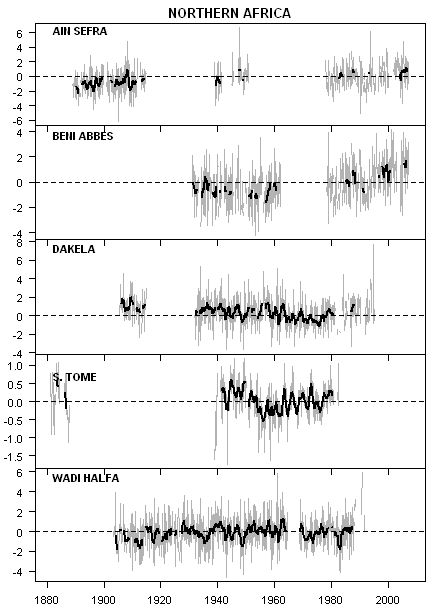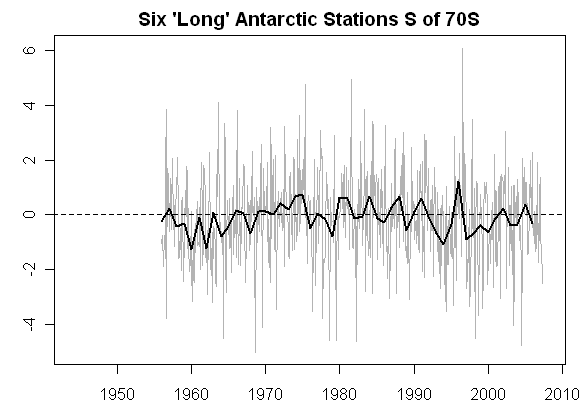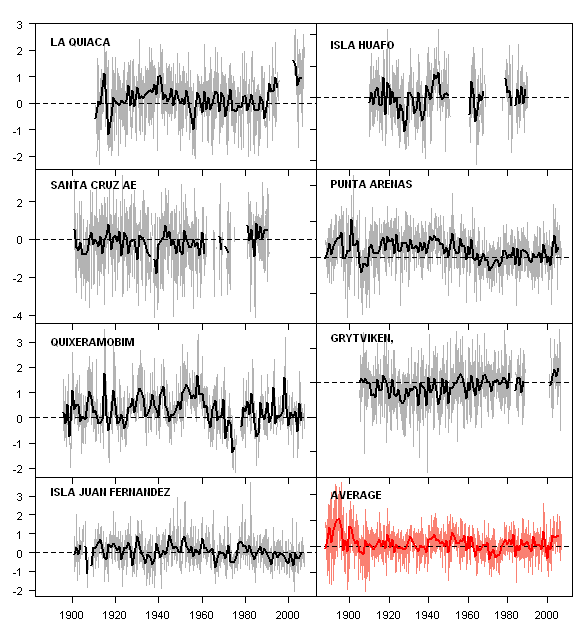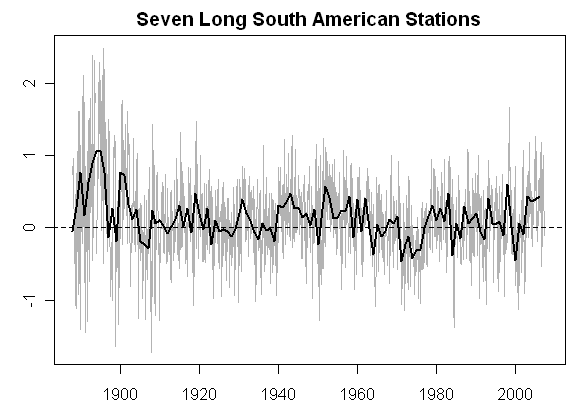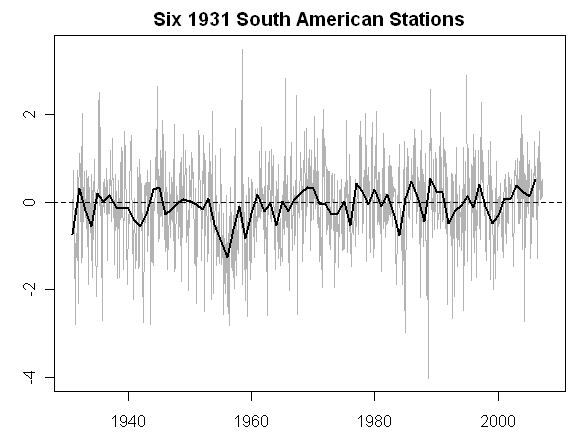Através do Meteored fui parar a um blogue interessante. Dum meteorologista americano chamado Anthony Watts, que está a questionar os dados das estações meteorológicas americanas, e por consequência, a temperatura global. Ele deu-se ao trabalho de visitar pessoalmente algumas dezenas de estações, e o que descobriu foi um pouco chocante. Muitas delas estavam pessimamente localizadas. Especula o autor, que muitas estações estão em ambiente urbano ou próximo, e destas umas quantas estão mal muito localizadas, dando seguramente origem a erros. Numa escala global, isto geraria um erro razoável, ao qual se junta a muito menor quantidade de estações em grandes extensões de terra onde não existe tanta presença humana.
Até que ponto estaremos a medir bem a temperatura da Terra ? Não poderá estar aí uma possível explicação para as diferenças do hemisfério norte vs. sul ? E se se gastam fortunas em investigação, cientistas, recursos, satélites e simulações, mas depois alguns dos dados de base que entram nos modelos não estão correctos porque muitas estações espalhadas pelo mundo estão meio esquecidas ou quase abandonadas?
É mais uma teoria, discutível certamente, mas tem pelo menos alguma lógica interessante.
E em Portugal ? Estará tudo bem configurado e localizado, e com uma boa distribuição entre zonas urbanas e rurais, etc, etc ?
O blogue em questão é este:
Watts Up With That? How not to measure temperature
http://www.norcalblogs.com/watts/weather_stations/
A pessoa em questão entretanto lançou um projecto na Net chamado SurfaceStations onde utilizadores de todo o país são convidados a verificar e documentar a situação das estações meteorlógicas das suas áreas de residência e a submeterem a informação para uma base dados. Independentemente da teoria parece-me uma ideia interessante, e que até poderia ser feito a nivel global.
SurfaceStations
http://www.surfacestations.org/
Até que ponto estaremos a medir bem a temperatura da Terra ? Não poderá estar aí uma possível explicação para as diferenças do hemisfério norte vs. sul ? E se se gastam fortunas em investigação, cientistas, recursos, satélites e simulações, mas depois alguns dos dados de base que entram nos modelos não estão correctos porque muitas estações espalhadas pelo mundo estão meio esquecidas ou quase abandonadas?
É mais uma teoria, discutível certamente, mas tem pelo menos alguma lógica interessante.
E em Portugal ? Estará tudo bem configurado e localizado, e com uma boa distribuição entre zonas urbanas e rurais, etc, etc ?
O blogue em questão é este:
Watts Up With That? How not to measure temperature
http://www.norcalblogs.com/watts/weather_stations/
A pessoa em questão entretanto lançou um projecto na Net chamado SurfaceStations onde utilizadores de todo o país são convidados a verificar e documentar a situação das estações meteorlógicas das suas áreas de residência e a submeterem a informação para uma base dados. Independentemente da teoria parece-me uma ideia interessante, e que até poderia ser feito a nivel global.
SurfaceStations
http://www.surfacestations.org/
Helping along global warming
Remember in January when the National Oceanic & Atmospheric Administration (NOAA) and its good friends in media trumpeted that 2006 was the warmest year on record for the contiguous United States?
NOAA based that finding - which allegedly capped a nine-year warming streak "unprecedented in the historical record" - on the daily temperature data that its National Climatic Data Center gathers from about 1,221 mostly rural weather observation stations around the country.
Few people have ever seen or even heard of these small, simple-but-reliable weather stations, which quietly make up what NOAA calls its United States Historical Climatology Network (USHCN).
But the stations play an important role in detecting and analyzing regional climate change. More ominously, they provide the official baseline historical temperature data that politically motivated global-warming alarmists like James Hansen of NASA plug into their computer climate models to predict various apocalypses.
NOAA says it uses these 1,221 weather stations -- which like the ones in Uniontown and New Castle are overseen by local National Weather Service offices and usually tended to by volunteers -- because they have been providing reliable temperature data since at least 1900.
But Anthony Watts of Chico, Calif., suspects NOAA temperature readings are not all they're cracked up to be. As the former TV meteorologist explains on his sophisticated, newly hatched Web site surfacestations.org, he has set out to do what big-time armchair-climate modelers like Hansen and no one else has ever done - physically quality-check each weather station to see if it's being operated properly.
To assure accuracy, stations (essentially older thermometers in little four-legged wooden sheds or digital thermometers mounted on poles) should be 100 feet from buildings, not placed on hot concrete, etc. But as photos on Watts' site show, the station in Forest Grove, Ore., stands 10 feet from an air-conditioning exhaust vent. In Roseburg, Ore., it's on a rooftop near an AC unit. In Tahoe, Calif., it's next to a drum where trash is burned.
Watts, who says he's a man of facts and science, isn't jumping to any rash conclusions based on the 40-some weather stations his volunteers have checked so far. But he said Tuesday that what he's finding raises doubts about NOAA's past and current temperature reports.
"I believe we will be able to demonstrate that some of the global warming increase is not from CO2 but from localized changes in the temperature-measurement environment."
Meanwhile, you probably missed the latest about 2006. As NOAA reported on May 1 - with minimum mainstream-media fanfare - 2006 actually was the second- warmest year ever recorded in America, not the first. At an annual average of 54.9 degrees F, it was a whopping 0.08 degrees cooler than 1998, still the hottest year.
NOAA explained that it had updated its 2006 report "to reflect revised statistics" and "better address uncertainties in the instrumental record." This tinkering is standard procedure. NOAA always scientifically tweaks temperature readings for various reasons -- weather stations are moved to different locations, modernized, affected by increased urbanization, etc.
NOAA didn't say whether it had adjusted for uncertainties caused by nearby burn barrels.
http://www.pittsburghlive.com/x/pittsburghtrib/opinion/columnists/steigerwald/s_513013.html




